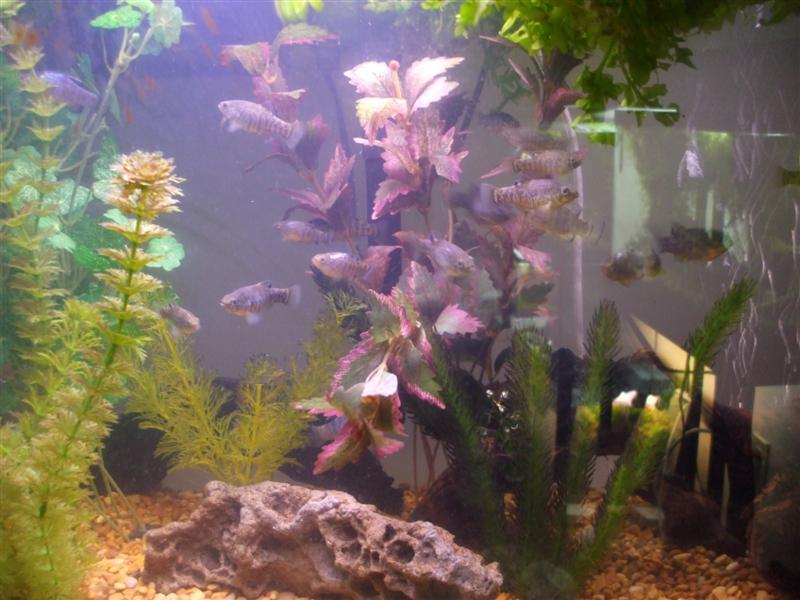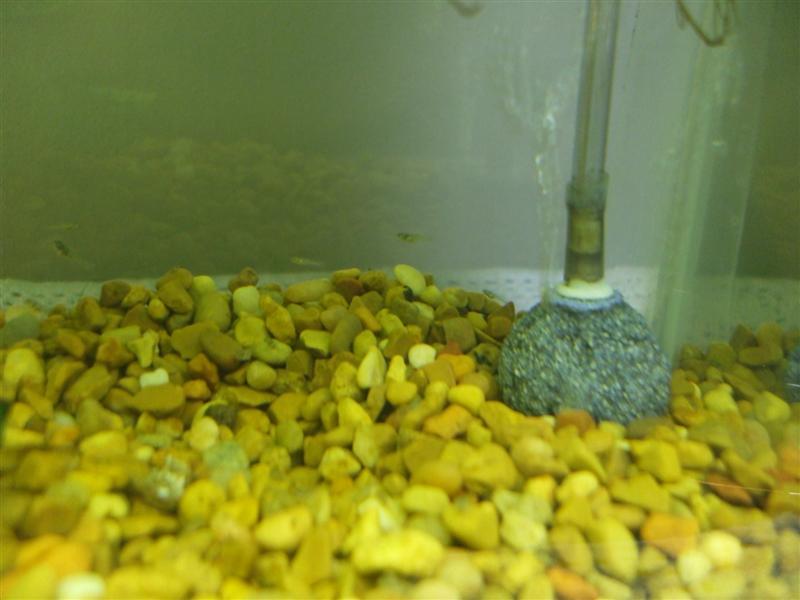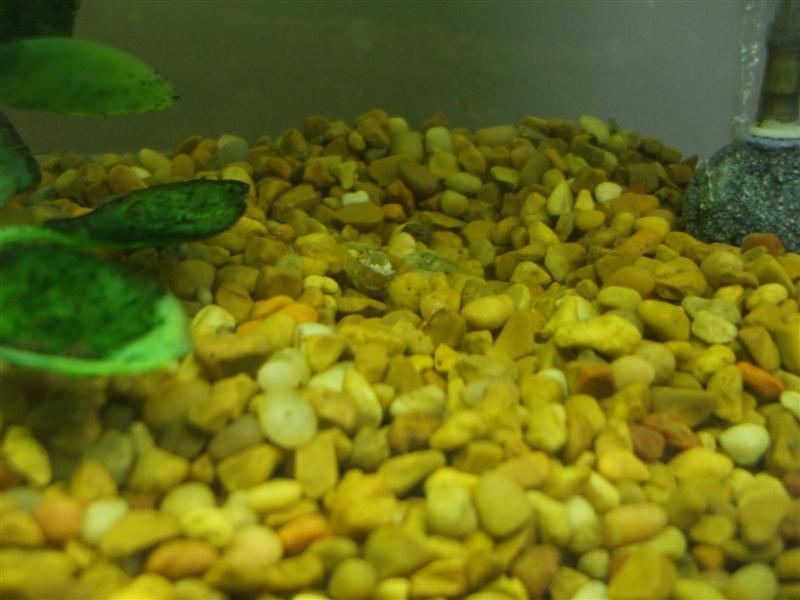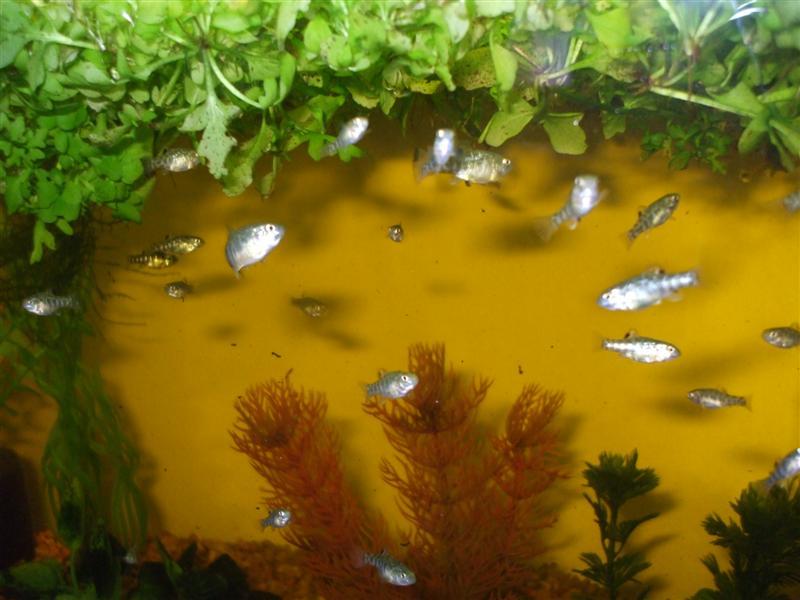Spawning Cyprinodon variegatus
#1
 Guest_baker46947_*
Guest_baker46947_*
Posted 09 August 2011 - 09:55 AM
#2
 Guest_UncleWillie_*
Guest_UncleWillie_*
Posted 09 August 2011 - 02:30 PM
Edited by UncleWillie, 09 August 2011 - 02:31 PM.
#3
 Guest_JamesH_*
Guest_JamesH_*
Posted 10 August 2011 - 10:42 AM
When I would remove the parents I would get many more fry per breeding. Everything sounds right for your group to breed. I know several other people that have been successful with spawning them in large rummbermaid tubs by placing the adults in the tub for 24 hours with the bottom covered with mops and then removing them. Good luck.
#5
 Guest_baker46947_*
Guest_baker46947_*
Posted 16 October 2011 - 10:16 AM
I guesss I'll do what I do every year. Do my best to keep them around till summer comes and put them out side in my pool(s). Filled with plants from near by lakes and my water lettuce.I have 2 female and 4 male C. variegatus in a 40 gal. breeder tank. I have added aquarium salt 1-2 Tbsp to 5 gal. Substrate is 1 mm. sand/gravel about 2' deep. I have some life plants (working on more). I would like to know how to get them to spawn inside. I have yarn mops. Should they float? or be sank?
#6
 Guest_Bob_*
Guest_Bob_*
Posted 18 October 2011 - 11:31 AM
Since they're probably in spawning mode, now, you can also try again.
What I do for most killies and lots of cyprinids is to put them in a bare tank. I add a tub full of stones pebbles and stones with lots of spaces and crevices between them. Then I take a big hunk of java moss from one of the other tanks, and then weigh it down on top of the tub with one of the stones.
I put the adults in the tank, bumping up the heater to the high 70s/low 80s, depending on the room temperature. Within two days to a week (whenever I get around to it) I take the adults out and wait for the fry to show up. At about this time, it's a good idea to seed the tank with vinegar eels and paramecium.
When I got mine to spawn I would place some yarn mops on the bottom and only leave the parents in the tank for 24-48 hours and then remove them. When I would leave them in the tanks they would eat most of the eggs and I might find one or two young fish.
When I would remove the parents I would get many more fry per breeding. Everything sounds right for your group to breed. I know several other people that have been successful with spawning them in large rummbermaid tubs by placing the adults in the tub for 24 hours with the bottom covered with mops and then removing them. Good luck.
#7
 Guest_haruspicator_*
Guest_haruspicator_*
Posted 17 November 2011 - 10:55 PM
Thanks!
#8
 Guest_Mysteryman_*
Guest_Mysteryman_*
Posted 17 December 2011 - 10:38 AM
#9
 Guest_melanotheron_*
Guest_melanotheron_*
Posted 20 October 2012 - 11:00 AM





 A good friend had a self sustaining Sheepshead tank for years and offered me her experience & pictures. She started with 2 males and three females from mailorder in fall of 2008. In an acrylic 5 gal. with gravel, driftwood, watersprite, java moss, plastic plants, a small outside power filter and approximately 1 Tbs. of synthetic sea salt to the gallon. Food was a variety of flakes. The males colored up quickly and set up territories on opposite sides of a driftwood branch. They courted the females continuously and when ripe they would press together into the gravel and deposit eggs. Within a few months there were a number of 1/2 inch fry living with the adults. In the winter of 2008 she upgraded the approximately 18 sheepsheads to a 15 gallon aquarium with similar conditions and added a sponge over the filter intake to keep fry out. Water changes were 30% to 50% every other week. This tank quickly got overcrowded with the sheepsheads and they were again moved to a 29 gallon. The empty 15 gallon was left running and quickly hatched out many more fry from eggs left in the gravel. She observed interesting fry behavior at this point. They were hopping around on the bottom or sitting on the bottom motionless. Like gobys. They stayed bottom dwellers till a size of about 1/3 inch. And she notes that the adults rarely feed off the bottom of the tank. So food dropping there, and the fry, were mostly ignored. However the fry were quite cannibalistic among themselves. The sheepsheads kept going untill a disease wiped them all out after 3 years. She wanted to stress that the adult males did well together at all times. No damage ever came from their constant sparring and displaying. Here are some pics of her selfsustaining sheepsheads, adults and fry!
A good friend had a self sustaining Sheepshead tank for years and offered me her experience & pictures. She started with 2 males and three females from mailorder in fall of 2008. In an acrylic 5 gal. with gravel, driftwood, watersprite, java moss, plastic plants, a small outside power filter and approximately 1 Tbs. of synthetic sea salt to the gallon. Food was a variety of flakes. The males colored up quickly and set up territories on opposite sides of a driftwood branch. They courted the females continuously and when ripe they would press together into the gravel and deposit eggs. Within a few months there were a number of 1/2 inch fry living with the adults. In the winter of 2008 she upgraded the approximately 18 sheepsheads to a 15 gallon aquarium with similar conditions and added a sponge over the filter intake to keep fry out. Water changes were 30% to 50% every other week. This tank quickly got overcrowded with the sheepsheads and they were again moved to a 29 gallon. The empty 15 gallon was left running and quickly hatched out many more fry from eggs left in the gravel. She observed interesting fry behavior at this point. They were hopping around on the bottom or sitting on the bottom motionless. Like gobys. They stayed bottom dwellers till a size of about 1/3 inch. And she notes that the adults rarely feed off the bottom of the tank. So food dropping there, and the fry, were mostly ignored. However the fry were quite cannibalistic among themselves. The sheepsheads kept going untill a disease wiped them all out after 3 years. She wanted to stress that the adult males did well together at all times. No damage ever came from their constant sparring and displaying. Here are some pics of her selfsustaining sheepsheads, adults and fry!
Reply to this topic
0 user(s) are reading this topic
0 members, 0 guests, 0 anonymous users







